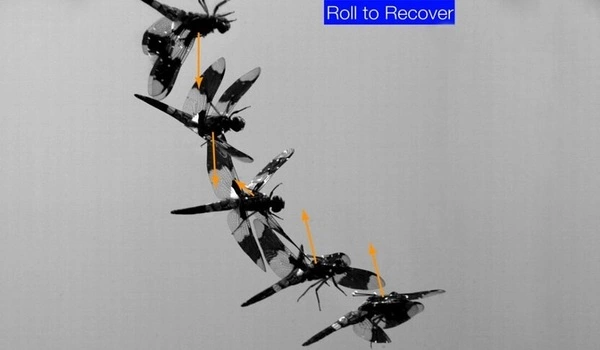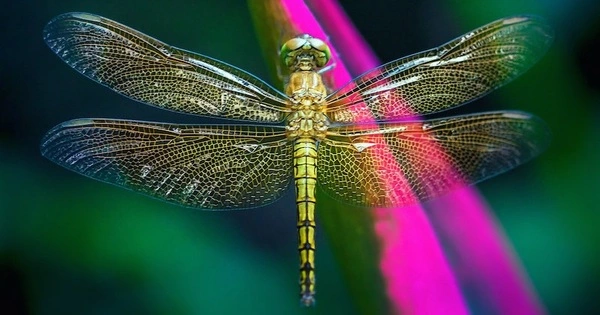The intricate physics and neural controls that allow dragonflies to right themselves while falling have been untangled by researchers. Dragonflies are a sight to behold, with their stretched bodies, massive wingspan, and iridescent coloring. Their originality, however, does not stop with their appearance: They were an early innovator of aerial flight as one of the oldest insect species on the planet.
Now, a team led by Jane Wang, a mechanical engineering and physics professor in the College of Arts and Sciences, has untangled the intricate physics and neural controls that allow dragonflies to right themselves while falling.
The study reveals a series of mechanisms that start with the dragonfly’s eyes (all five of them) and progresses through its muscles and wing pitch. The team’s paper, “Recovery Mechanisms in the Dragonfly Righting Reflex,” was published in Science on May 12th. Wang worked with James Melfi, Ph.D. ’15, and Anthony Leonardo of the Howard Hughes Medical Institute (HHMI) in Ashburn, Virginia, to co-author the paper.
Wang has spent the last two decades studying the mechanics of insect flight using complex mathematical modeling. Wang believes that physics is as important as genetics in explaining the evolution of living organisms.
“Insects are the most numerous species, and they were the first to discover aerial flight. And dragonflies are among the oldest insects “Wang stated. “Trying to look at how they right themselves in air would give us insight into the origins of flight as well as how animals evolved neuro-circuitries for balancing in air and navigating through space.”
When we looked at their flight behavior, we were simultaneously in awe and frustrated. The trajectories are complex and unpredictable. Dragonflies constantly make maneuvers, without following any obvious direction. It’s mysterious.
Jane Wang
Wang began working on the project several years ago as a visiting scientist at HHMI’s Janelia Research Campus, where her collaborator Leonardo was 3D-tracking dragonflies in a large arena. Wang was inspired to investigate them further.
“When we looked at their flight behavior, we were simultaneously in awe and frustrated,” she said. “The trajectories are complex and unpredictable. Dragonflies constantly make maneuvers, without following any obvious direction. It’s mysterious.”
To study these flight dynamics and the internal algorithms that govern them, Wang and Melfi designed a controlled-behavioral experiment in which a dragonfly would be dropped upside down from a magnetic tether — a premise not unlike the famous falling cat experiments from the 1800s that showed how certain “hardwired reflexes” resulted in the felines landing on their feet.
Wang and Melfi discovered that by carefully releasing a dragonfly without making contact with its legs, the insect’s perplexing maneuvers followed the same pattern of motion, which the researchers were able to capture with three high-speed video cameras filming at 4,000 frames per second. The dragonfly’s wings and body were marked with markers, and the motions were reconstructed using 3D-tracking software.
Then came the most difficult part: attempting to make sense of the movements. The researchers had to take into account a variety of factors, ranging from the unsteady aerodynamics of wing and air interactions to how a dragonfly’s body responds to its wings flapping. There’s also gravity, the fickle force with which all earthly beings must eventually contend.

Wang and Melfi were able to create a computational model that successfully simulated the dragonfly’s aerobatics. But one key question lingered: How do dragonflies know they are falling, so that they can correct their trajectory?
Wang realized that, unlike humans, dragonflies could use their two visual systems to determine their uprightness: a pair of large compound eyes and three simple eyes called ocelli. She put her theory to the test by painting over a dragonfly’s eyes and repeating the experiment. The dragonfly had much more difficulty recovering mid-flight this time. “These results indicate that vision is the first and most important pathway for initiating the dragonfly’s righting reflex,” Wang said.
This visual cue triggers a series of reflexes that send neural signals to the dragonfly’s four wings, which are powered by a set of direct muscles that modulate the left-wing and right-wing pitch asymmetry accordingly. A tumbling dragonfly can turn 180 degrees and resume flying right-side up with three or four wing strokes. The entire procedure takes about 200 milliseconds.
“What was difficult was determining the key control strategy from the experimental data,” Wang explained. “It took us a long time to figure out how a small amount of pitch asymmetry could result in the observed rotation. The key asymmetry is hidden among many other changes.”
The combination of kinematic analysis, physical modeling, and 3D flight simulations now allows researchers to infer the critical links between an animal’s observed behaviors and the internal procedures that control them in a noninvasive manner. Engineers looking to improve the performance of small flying machines and robots can also benefit from these findings.
“It’s difficult to engineer flight control on the timescale of tens or hundreds of milliseconds,” Wang said. “Small flapping machines can now take off and turn, but they still have difficulty staying aloft. It is difficult to correct when they tilt. One of the things that animals must do is solve these types of problems.”





